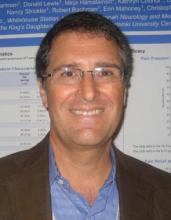ORLANDO – Environmental stressors play a large role in triggering migraines in children, according to Dr. Eric Pearlman.
"Migraine is definitely a pediatric disorder. It peaks in young adulthood, but it definitely occurs in kids," Dr. Pearlman, chair of the department of pediatrics at Mercer University in Savannah, Ga., said at the annual meeting of the American Academy of Pediatrics.
Epidemiologic data suggest that migraine occurs in 10.5% of 10- to 15-year-old children and 3% of 7-year-olds, and that headaches – possibly including migraines – occur in 4% of 3-year-olds. By about 13 years of age, the prevalence of migraines starts reaching adult levels of about 6% in males, and 18% in females.
Environmental factors such as sleep deprivation, dehydration, dietary factors, school stressors, hidden stressors (like peers), and hormonal fluctuations represent triggers that can be particularly pronounced in children, he noted.
With International Classification of Headache Disorders, third edition (ICHD-III) criteria, migraines can be differentiated from acute, acute recurrent, and chronic progressive or chronic nonprogressive headaches if a child has experienced at least five attacks lasting up to 72 hours (whether untreated or unsuccessfully treated), if nausea and/or vomiting or photophobia and phonophobia are present, and if the child has at least two of four characteristics, including unilateral location, pulsating quality, moderate to severe intensity, and a tendency to be aggravated by – or avoid – routine physical activity.
In children, photophobia and phonophobia can be inferred (if they report having to lie down in a dark, quiet room, for example), as many have difficulty describing or understanding these symptoms
Unilateral headaches are rare in children, Dr. Pearlman noted.
If a diagnosis of migraine is established, it is important to make the diagnosis known to the child, and to educate the child about the condition and treatments.
Consider providing handouts and referring to websites (such as the American Headache Society or the National Headache Foundation sites), to help educate patients and to manage their expectations, as they need to understand you cannot cure their migraine, he advised.
Involving both the patient and their parents in decision making can improve compliance with treatment recommendations, he said.
Pharmacologic interventions can include nonspecific short-term therapies, migraine-specific therapies, and preventive treatment.
Nonspecific short-term therapies may include acetaminophen, nonsteroidal anti-inflammatory drugs, or combination drugs. Migraine-specific therapies include ergotamine and dihydroergotamine, and the "triptans."
Seven triptans are available, including two that are approved for use in children; rizitriptan (Maxalt) is approved for children older than age 6 years, and almitriptan (Axert) is approved for those aged 12-17 years.
Maxalt comes in both an oral and orally disintegrating form, and is available as a generic drug. Generic sumitriptan (Imitrex) also is available.
"There are good data for most of the triptans for adolescents aged 12 and older," Dr. Pearlman said.
Rescue medications for those who have an inadequate response to short-term therapy can include a combination of an analgesic like a nonsteroidal and an antiemetic, or an opiate and an antiemetic if the patient used a nonsteroidal initially. Rescue medications may be needed "because nothing is going to work 100% of the time," he said.
Preventive medications include beta-blockers, antidepressants, and antiseizure drugs.
The decision to use these medications should be based on attack frequency, disability associated with an attack, tolerance of short-term medication, and patient preference, and the choice of preventive medication depends on factors such as coexisting conditions, age, and prior medications use.
In a child with a sleep disorder, attention-deficit hyperactivity disorder, or depression, a tricyclic antidepressant such as amitriptyline might be considered; for a child with epilepsy, topirimate may be a good choice.
"If they have orthostatic intolerance, you think about a beta-blocker. If they are overweight, you want to stay away from medicine that causes weight gain – you might think about something like Topamax. For asthma and allergy you want to stay away from beta-blockers," he said, noting that these "are just some general principles."
Keep in mind that migraineurs are very sensitive to medicines, so it is important to start with a low dose and increase the dose slowly if needed, he said, also noting that the response to preventive medication takes time.
In studies of drugs that work for prevention, about 50% of patients had a 50% reduction in headaches, so managing expectations is important.
"You want to give a minimum of 2 months of a trial at a good dose," he said.
Treatment duration depends on response.
"Three months, 6 months, a year – sometimes longer if it takes a while to get them under control," he said, noting that he tends to take children off of preventives during the summer when they are less likely to experience the types of stress that can trigger migraines, and that he avoids taking them off of treatment at the beginning of the school year or during exams.


